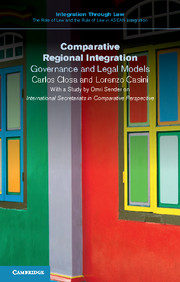Book contents
- Frontmatter
- Contents
- List of figures
- List of tables
- General editors’ preface
- Preface
- List of abbreviations
- Chapter 1 Governance structures and processes in integration organizations
- Chapter 2 The development of international legal regimes
- Study Lead, follow or get out of the way? International secretariats in comparative perspective
- Executive summary
- Index
Executive summary
Published online by Cambridge University Press: 05 August 2016
- Frontmatter
- Contents
- List of figures
- List of tables
- General editors’ preface
- Preface
- List of abbreviations
- Chapter 1 Governance structures and processes in integration organizations
- Chapter 2 The development of international legal regimes
- Study Lead, follow or get out of the way? International secretariats in comparative perspective
- Executive summary
- Index
Summary
States formalize their cooperative relations with the aim of providing, together, certain public goods that they cannot provide in isolation. The range of these goods is greatly varied, encompassing security, identity and religion; and development, infrastructure and regulatory frameworks for trade, labor or air transport, for instance. To this end, States accept to be bound by formal arrangements whereby they commit to deliver these goods, but also to respect the agreements concluded. Formal institutions respond precisely to these needs for provision and commitment.
Globalization has underlined the inability of States to provide goods in isolation and has hence accelerated legal integration at international and supranational levels: the number of international institutions – now over 60,000 – began growing after the Second World War and is still rising; the relations between State administrations and international institutions are becoming ever more numerous; forms of regional organization have been spreading; new forms of global networks and global “administrations” have been developing. As a consequence, scholars worldwide have devoted themselves to studying global governance, international organizations and regionalism. From these various perspectives, what has emerged clearly is that a mono-disciplinary approach is not capable of capturing all the implications related to these issues, which means that it becomes crucial to combine different fields of research. In this context, the use of concepts derived from both political science and law has turned out to be extremely effective, such as in the case of regime theory being used to explain the formation of global regulatory systems. This is why this book presents these two perspectives jointly, in its endeavor to define models of international and supranational legal integration.
Our aim, therefore, is threefold. First, we map and outline models of regional integration by studying their institutional design and processes of governance. Second, we extend our analysis to IOs and other international regimes, to identify which techniques are capable of governing complex global legal systems. Third, we offer a toolbox of institutional processes and legal mechanisms, which may be adopted by current or new projects of international and supranational integration, such as ASEAN. We address these aims in two chapters, both based on the idea of integration as a formal process.
- Type
- Chapter
- Information
- Comparative Regional IntegrationGovernance and Legal Models, pp. 465 - 470Publisher: Cambridge University PressPrint publication year: 2016

